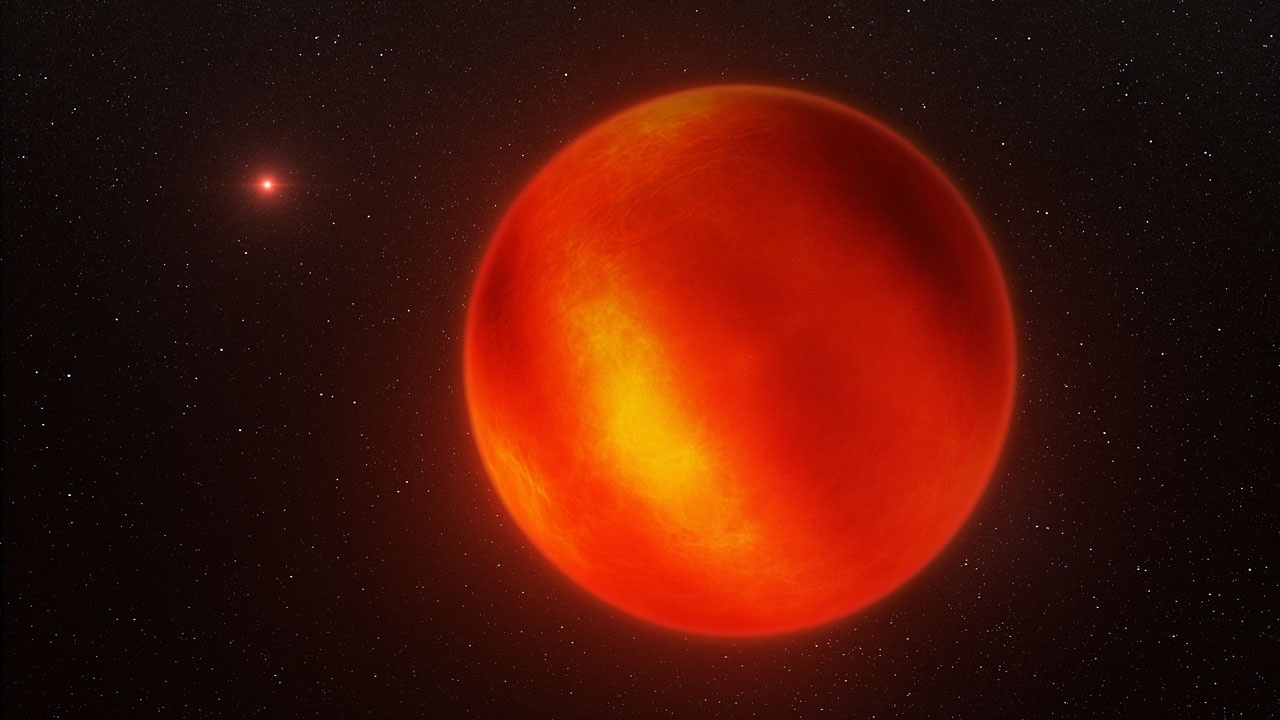
The James Webb Space Telescope (JWST) has discovered stormy weather in the sky of two brown dwarfs in the most detailed weather report yet from such "failed stars."
The two brown dwarfs form a binary pair called WISE 1049AB that was discovered by NASA's Wide-field Infrared Survey Explorer (WISE) in 2013; the duo sits just 6.5 light-years away from us. They are the closest brown dwarfs to our sun, and thus make an excellent target for the James Webb Space Telescope's powerful infrared instruments.
A brown dwarf is an object that isn't quite massive enough to ignite the nuclear fusion of hydrogen to helium in its core and become a fully fledged star — yet is also considered too massive to be a planet and thought to form like stars do (via the gravitational collapse of a cloud of molecular gas). As such, brown dwarfs are thought of as a missing link between gas giant planets like Jupiter, and the lowest mass stars, M-dwarfs.
Previous observations have probed the atmosphere of various brown dwarfs, but they have always been limited to time-averaged snapshots, meaning we could not see things in the brown-dwarf atmosphere changing with time. However, brown dwarfs are fast rotators — WISE 1049A spins on its axis once every 7 hours, and B once every 5 hours — and the conditions in their atmospheres can alter over time, meaning that previous observations that didn't factor in the objects' evolutions could have missed lots of variability.
Related: James Webb Space Telescope's 'shocking' discovery may hint at hidden exomoon around 'failed star'
The JWST, however, does have the ability to detect these changes over time. A team led by Beth Biller of the University of Edinburgh observed WISE 1049AB for 8 hours with the JWST's Mid-Infrared Instrument (MIRI), and then immediately afterward for another 7 hours with its Near-Infrared Spectrometer (NIRSpec).
The researchers found that both brown dwarfs are covered in tumultuous clouds, probably composed of silicate grains, sweltering in temperatures between 875 degrees Celsius (1,610 degrees F) and 1,026 degrees Celsius (1880 degrees F). In other words, hot sand is being blown in the winds of the brown dwarfs. The absorption signatures of carbon monoxide, methane and water vapor were also identified.
Intriguingly, the light curve for each brown dwarf (a graph of each brown dwarf's brightness over time) displays considerable variability. This has been interpreted as stormy conditions blowing clouds at various altitudes, and gaps appearing between those clouds that allows for views into deeper layers of the atmosphere. The light curves also show peaks at specific wavelengths — carbon monoxide at 2.3 microns and 4.2 microns (millionths of a meter), methane at 3.3 microns, and silicate grains tentatively at 8.3 microns to 8.5 microns.

Biller's team interpret the peaks at these wavelengths as indicating three different layers where there is a significant change in atmospheric pressure on each brown dwarf. There's a deep layer producing signals greater than 2.3 microns but less than 8.5 microns, an intermediate altitude layer absorbing light at between 2.3 and 4.2 microns, and a high altitude layer with exhibiting signals between 4.2 and 8.5 microns.
The findings indicate the power of the JWST to be able to probe, for the first time, the vertical profile (i.e. the conditions at different depths) of the atmosphere of a brown dwarf, and, in fact, there's no reason the JWST has to stop there. As the research paper describing the findings concludes: "This is the first such study, but will not be the last — in the next few observing cycles, JWST will transform our understanding of both brown dwarf and young, giant exoplanet atmospheres."
"Our findings show that we are on the cusp of transforming our understanding of worlds far beyond our own," said Biller in a statement. "Insights such as these can help us understand the conditions not just on celestial objects like brown dwarfs, but also on giant exoplanets beyond our solar system. Eventually, the techniques we are refining here may enable the first detections of weather on habitable planets like our own, which orbit other stars."
The findings were published on July 15 in the Monthly Notices of the Royal Astronomical Society.





!["[T]he First and Fifth Amendments Require ICE to Provide Information About the Whereabouts of a Detained Person"](https://images.inkl.com/s3/publisher/cover/212/reason-cover.png?w=600)

